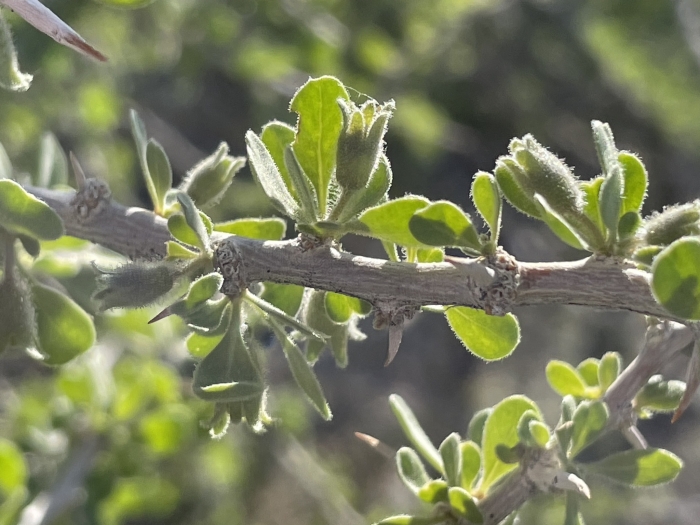Peach Thorn
(Lycium cooperi)
Peach Thorn (Lycium cooperi)
/
/

Bobby McCabe
CC BY 4.0
Image By:
Bobby McCabe
Recorded By:
Copyright:
CC BY 4.0
Copyright Notice:
Photo by: Bobby McCabe | License Type: CC BY 4.0 | License URL: http://creativecommons.org/licenses/by/4.0/ | Rights Holder: Bobby McCabe | Publisher: iNaturalist | Date Created: 2022-04-14T00:22:27Z |

























Estimated Native Range
Summary
Lycium cooperi, commonly known as Peach Thorn, is a deciduous shrub native to the deserts and arid mountainous regions of the southwestern United States, particularly in Nevada, Utah, Arizona, and California. It typically grows to a height of up to 13 feet (4 meters) and has a bushy, erect form with many rigid, thorny branches. The leaves of Peach Thorn are fleshy, oval to lance-shaped, measuring 0-1 inch long, and are coated with glandular hairs that give them a sticky texture. This shrub produces an inflorescence of small clusters of tubular flowers, each 0-1 inch long, with white or greenish petals and distinctive lavender or green veining. The flowers bloom from late spring to early summer and are followed by yellow or orange berries, each under a centimeter wide, containing numerous seeds.
Peach Thorn is valued for its drought tolerance and ability to thrive in poor, well-drained soils, making it an excellent choice for xeriscaping and naturalistic plantings in arid regions. It is also used for erosion control on slopes and in restoration projects. The plant’s thorny branches provide shelter for wildlife, while its berries are a food source for birds. In cultivation, it requires minimal water once established and prefers full sun exposure. While it is not commonly afflicted by diseases, it can be susceptible to root rot if overwatered or planted in poorly drained soils.CC BY-SA 4.0
Peach Thorn is valued for its drought tolerance and ability to thrive in poor, well-drained soils, making it an excellent choice for xeriscaping and naturalistic plantings in arid regions. It is also used for erosion control on slopes and in restoration projects. The plant’s thorny branches provide shelter for wildlife, while its berries are a food source for birds. In cultivation, it requires minimal water once established and prefers full sun exposure. While it is not commonly afflicted by diseases, it can be susceptible to root rot if overwatered or planted in poorly drained soils.CC BY-SA 4.0
Plant Description
- Plant Type: Shrub
- Height: 3-10 feet
- Width: 3-6 feet
- Growth Rate: Moderate
- Flower Color: Green, Purple, White
- Flowering Season: Spring
- Leaf Retention: Semi-deciduous
Growth Requirements
- Sun: Full Sun
- Water: Low
- Drainage: Medium, Fast
Common Uses
Bird Garden, Drought Tolerant, Erosion Control, Low Maintenance
Natural Habitat
Native to deserts and arid mountainous regions of the southwestern United States
Other Names
Common Names: Peach Thorn, True Wolfberry, Cooper’s Wolfberry
Scientific Names: , Lycium cooperi, Lycium cooperi var. pubiflora,
GBIF Accepted Name: